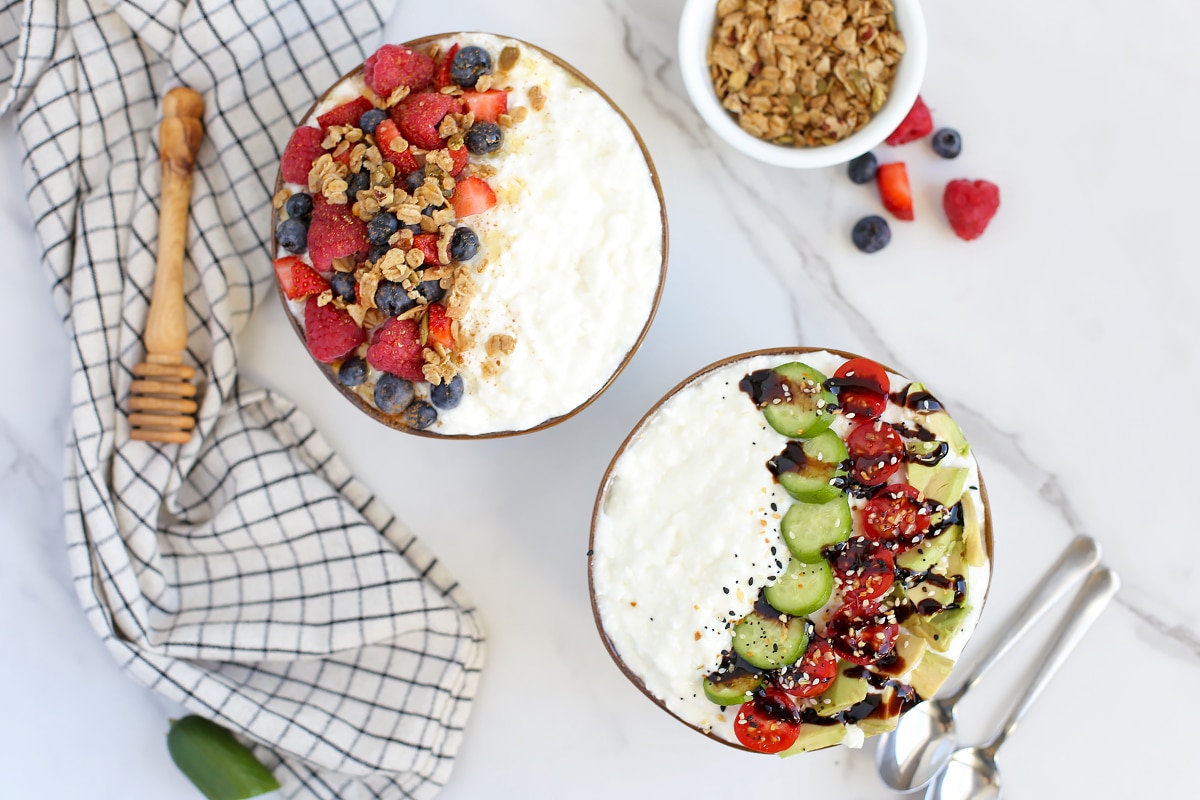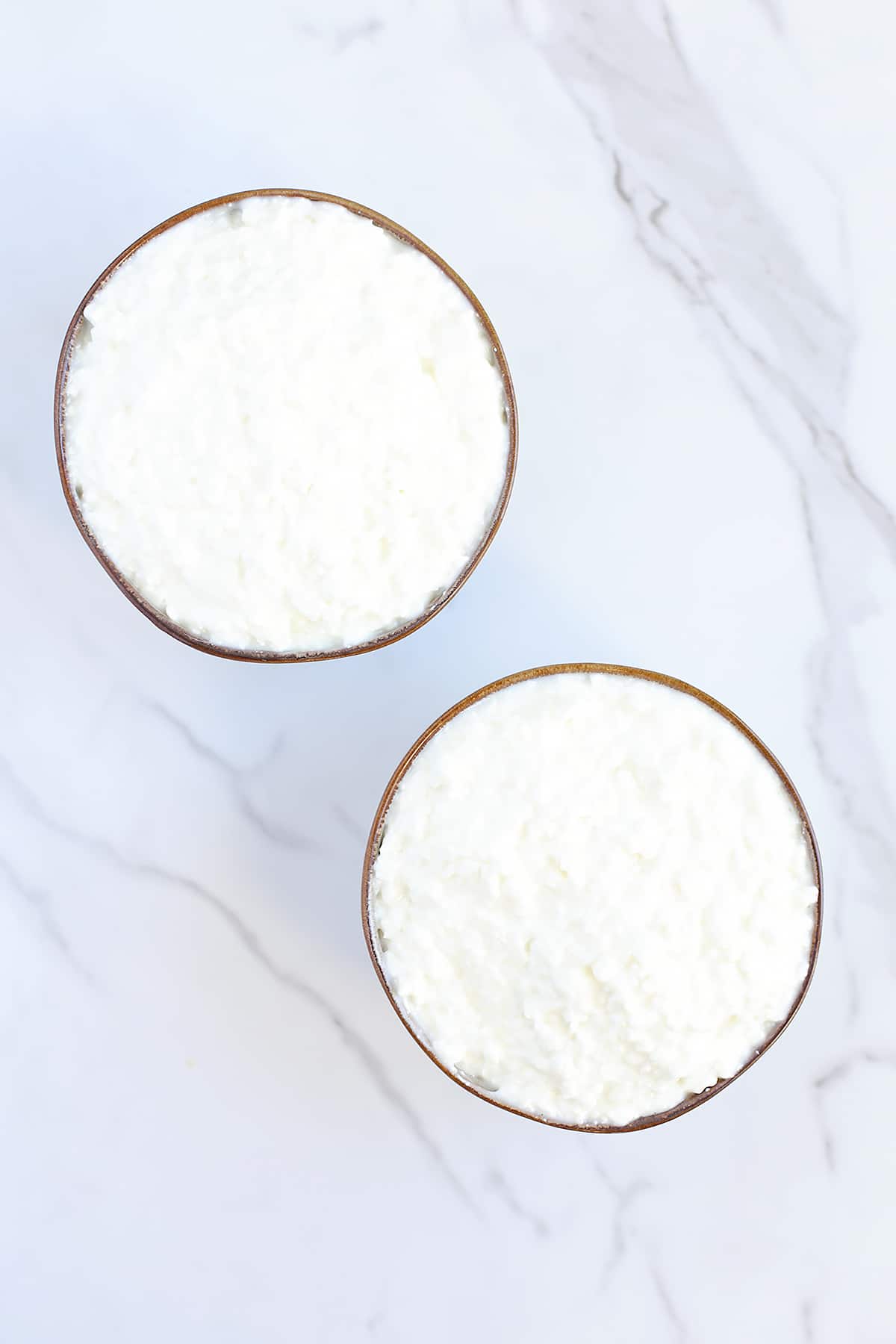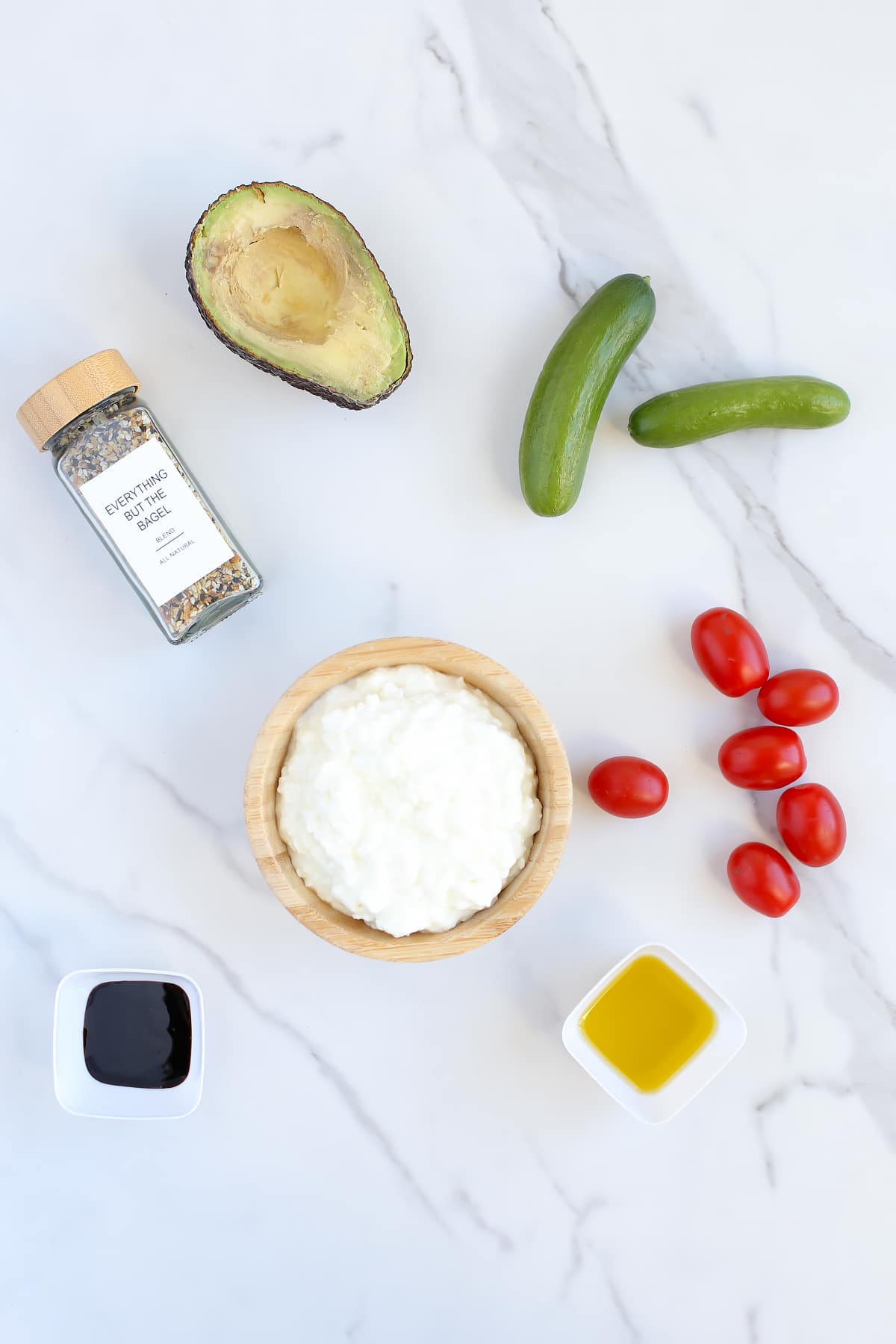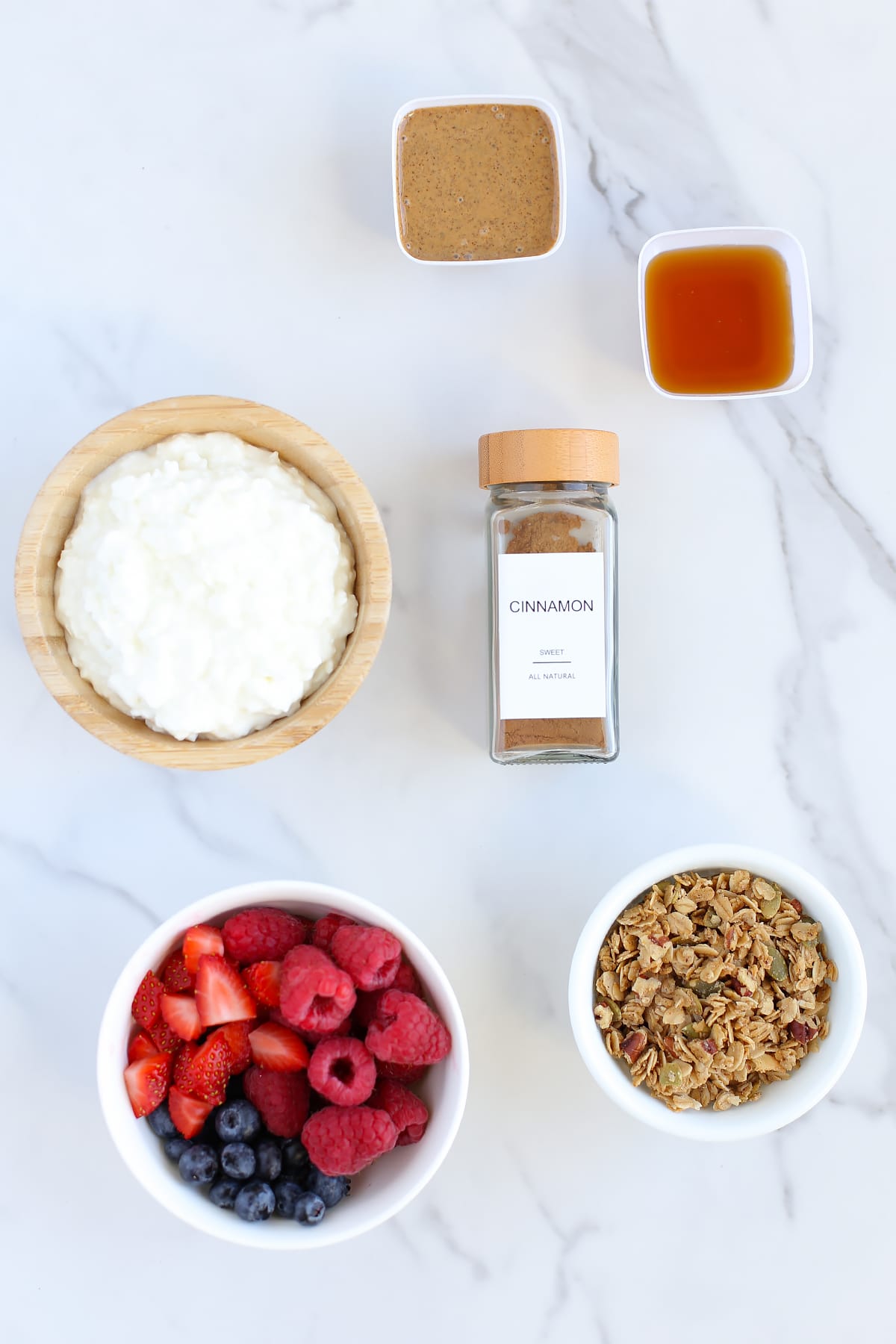
Elevate your snack game with these high-protein cottage cheese bowls, loaded with fresh ingredients for a deliciously nutritious boost. Perfect for breakfast or to refuel after a sports practice or workout, these bowls are a creamy, satisfying way to fuel your day.
Why Eat Cottage Cheese
Cottage cheese is a nutritious, versatile, and convenient food that provides numerous health benefits. Whether you are looking to increase your protein intake, support bone health, or enjoy a low-calorie snack, cottage cheese is an excellent choice.
- High in Protein: Cottage cheese is a really good source of protein, which is essential for muscle repair, growth, and overall body function. One cup of cottage cheese can contain up to 28 grams of protein!!
- Rich in Essential Nutrients: It provides a good amount of calcium, which is vital for bone health. It also contains B vitamins, such as B12, which supports brain health and energy production
- Supports Gut Health: Some cottage cheese contains probiotics, which can help maintain a healthy balance of bacteria in your gut. Look for terms like “live and active cultures,” “probiotics,” or specific strains of bacteria such as Lactobacillus or Bifidobacterium on the label to know if your cottage cheese contains probiotics. These brands of cottage cheese have probiotics:
- Versatile and Delicious: Whether you prefer sweet or savory, cottage cheese can be paired with a variety of ingredients to create a delicious and satisfying snack.
Why is Cottage Cheese So High in Protein?
When cottage cheese is made, it undergoes minimal processing compared to other dairy products. This helps retain the natural protein content found in milk. The curds are typically formed by adding a bacterial culture to milk, which increases the acidity and causes the casein proteins to coagulate and separate from the liquid whey.
The curds are rich in casein, a slow-digesting milk protein. Casein accounts for about 80% of the protein in milk and is known for its high-quality amino acid profile.
Which Type of Cottage Cheese Should I Buy?
Choosing the right type of cottage cheese depends on your dietary needs, taste preferences, and health goals. Here are some factors to consider when deciding which type of cottage cheese to buy:
Fat Content
- If you are trying to reduce saturated fat, low fat cottage cheese (2% or 1%) and non fat cottage cheese are good choices. They provide the protein benefits without the higher fat content.
- Full-fat cottage cheese (4% milkfat) can be more satisfying and may keep you full longer due to the higher fat content. It’s a good option if you need more calories or prefer a creamier texture.
Sodium Content
Some cottage cheeses are high in sodium, which can be a concern for those managing blood pressure or following a low-sodium diet. Typically anything less than 140mg per serving is considered low sodium.
Low-Sodium Cottage Cheese Brands:
- Hood Low Sodium Cottage Cheese: Contains 60 mg of sodium per half-cup serving.
- Lucerne Low Sodium Cottage Cheese: Contains 140 mg of sodium per half-cup serving.
- Friendship Dairies 1% No Salt Added Cottage Cheese: Contains 60 mg of sodium per half-cup serving.
Added Probiotics
Some brands add probiotics to their cottage cheese, which can aid in digestion and support gut health. These brands are known for including probiotics:
- Good Culture
- Nancy’s Probiotic Cottage Cheese
Ingredient Quality
Organic cottage cheese is made from milk produced without the use of synthetic pesticides or hormones. Some people prefer organic for perceived health benefits and environmental reasons. Additionally, cottage cheese without added preservatives or artificial ingredients may be a better choice for those looking to eat clean.
Texture and Taste
Cottage cheese can vary in texture from small curds to large curds. Some people prefer the smoother, creamier texture of small curds, while others like the chunkier feel of large curds. Some brands have a richer, creamier taste, while others might be tangier. Trying different brands can help you find the one that suits your taste buds best.
Specific Brand Recommendations
- Good Culture: Known for high-quality ingredients and added probiotics.
- Nancy’s Probiotic Cottage Cheese: Another great option for those looking for probiotic benefits.
- Daisy Cottage Cheese: Praised for its simple ingredient list and clean taste.

Topping and Mix-In Ideas
Some people don’t like the flavor of plain cottage cheese, but because it is so high in protein want to eat it anyway. And that is where toppings and mix-ins shine!
The ingredients for both of my savory and sweet cottage cheese bowls add lots of flavor and texture and are absolutely delicious! There are also lots of other delicious ideas so keep reading!
Savory Cottage Cheese Bowl Ingredients
- Avocado
- Cucumber
- Cherry Tomatoes
- Balsamic Vinegar
- Everything But the Bagel Seasoning
More Savory Topping Ideas:
- Fresh salsa or Pico de gallo
- Sun-Dried Tomatoes
- Olives
- chives, dill, basil, and black pepper
- avocado, lime, and cilantro + tortilla chips for dipping
- tomato, cucumber, and feta cheese

Sweet Cottage Cheese Bowl Ingredients:
- fresh berries
- granola
- honey
- almond butter
- cinnamon
More Sweet Ideas:
- sliced bananas, peaches, pineapple, and apples
- almonds, walnuts, pistachios, chia seeds, or flaxseeds
- raisins, dried cranberries, or apricots
- peanut butter + banana
- maple syrup

What is Better: Cottage Cheese or Greek Yogurt?
Both cottage cheese and yogurt have lots health benefits, so the better choice depends on your specific nutritional needs and preferences:
- Protein Content:
- Greek Yogurt generally has higher protein content compared to cottage cheese, making it beneficial for those looking to increase protein intake.
- Probiotics:
- Greek Yogurt naturally contains probiotics because of the fermentation process, and cottage cheese does not. Only specific brands of cottage cheese contain probiotics.
- Calcium Content:
- Both options are good sources of calcium, which is essential for bone health. Cottage cheese is slightly higher in calcium content compared to yogurt.
- Fat and Sodium Levels:
- Depending on the type (full-fat, low-fat, fat-free), both cottage cheese and yogurt can have different levels of fat and sodium. Choosing low-fat or fat-free options can help reduce saturated fats and sodium intake.
- Carbohydrate Content:
- Cottage cheese generally has lower carbohydrates compared to yogurt.
- Nutrient Profile:
- Greek Yogurt provides additional nutrients like B vitamins (especially B12), potassium, and magnesium, depending on the variety and brand.
Choosing Between Them:
- Protein Focus: If you prioritize protein intake, Greek yogurt might be better due to its higher protein content.
- Digestive Health: For gut health benefits from probiotics, yogurt is the clear winner.
- Calcium Needs: Both are good sources, but if you need a slightly higher calcium intake, cottage cheese might be preferable.
- Lower Carb Diet: Cottage cheese is lower in carbs, which could be advantageous for low-carb diets, especially for people with diabetes.

Recipes That We Love with Cottage Cheese
High Protein Cottage Cheese Bowls
Servings: 4 Bowls
Calories: 209kcal
Sweet Cottage Cheese Bowl (makes 2 bowls)
- 1 cup cottage cheese 2% fat or lower
- 1 cup berries blueberries, strawberries, raspberries
- 1/3 cup granola
- 2 teaspoons honey
- 1 tablespoon nut butter almond or peanut butter
- sprinkle of cinnamon
Savory Cottage Cheese Bowl (makes 2 bowls)
Sweet Cottage Cheese Bowl
-
Rinse berries and chop the strawberries. Add to the top of the cottage cheese. Sprinkle with granola. Drizzle nut butter, honey and add a sprinkle of cinnamon to the top of each both. Serve and enjoy!
Savory Cottage Cheese Bowl
Calories: 209kcal | Carbohydrates: 20g | Protein: 17g | Fat: 7g | Saturated Fat: 1g | Polyunsaturated Fat: 1g | Monounsaturated Fat: 3g | Cholesterol: 5mg | Sodium: 466mg | Potassium: 313mg | Fiber: 3g | Sugar: 12g | Vitamin A: 185IU | Vitamin C: 7mg | Calcium: 101mg | Iron: 1mg
www.superhealthykids.com

Natalie Monson
I’m a registered dietitian, mom of 4, avid lover of food and strong promoter of healthy habits. Here you will find lots of delicious recipes full of fruits and veggies, tips for getting your kids to eat better and become intuitive eaters and lots of resources for feeding your family.
Learn More about Natalie





